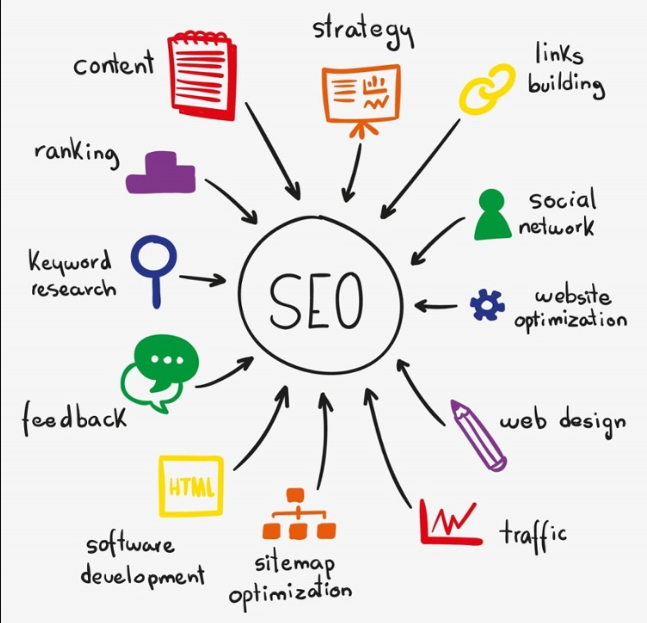Understanding the Function of Individual Experience in Modern SEO Practices
In an age where electronic presence can make or break a service, understanding the crossway between individual experience (UX) and modern-day search engine optimization methods is more essential than ever before. As online search engine progress, they progressively prioritize web sites that supply smooth, interesting experiences to users. Aspects such as website speed, mobile-friendliness, and user-friendly navigation are no more mere improvements; they are crucial to search engine optimization success. Just how do these aspects specifically influence search positions? And just how can organizations ensure their digital material not only meets but goes beyond progressing assumptions? These concerns create the foundation of a crucial discussion.
The Evolution of SEO
Throughout the years, the landscape of search engine optimization (SEARCH ENGINE OPTIMIZATION) has actually undertaken substantial transformation, reflecting the vibrant nature of electronic innovation and individual habits. Initially, search engine optimization was primarily concerning keyword stuffing and link-building methods, focusing heavily on manipulating internet search engine formulas to improve internet site rankings. However, as internet search engine came to be more innovative, these techniques started to lose performance and significance.

In addition, mobile optimization and voice search have actually ended up being essential components of search engine optimization methods. With the expansion of smartphones, guaranteeing sites are mobile-friendly has become a requirement. Voice search, driven by online aides like Siri and Alexa, has even more moved search engine optimization practices in the direction of natural language processing and conversational material.
Basically, the advancement of SEO reflects a broader pattern in the direction of boosting user contentment by straightening digital web content with the nuanced assumptions of modern individuals.
Secret UX Aspects in Search Engine Optimization
In the realm of search engine optimization, vital individual experience (UX) aspects are critical for boosting both user contentment and search engine rankings. Web sites maximized for mobile use not just promote a seamless individual experience however also line up with Google's mobile-first indexing method.
An additional important UX component is engaging web content layout. Web content should exist in a fashion that is both visually enticing and simple to absorb. This entails the strategic use of headings, bullet factors, and multimedia aspects, which can improve user involvement and decrease bounce rates. Clear call-to-action (CTA) buttons direct individuals in the direction of desired activities, enhancing conversion prices. Access can not be forgotten; making sure that material is obtainable to customers with specials needs expands reach and complies with web criteria. Incorporating these UX aspects successfully supports search engine optimization initiatives by advertising user retention and promoting internet search engine understanding of site material.
Impact of Website Rate
While commonly undervalued, the impact of site rate on customer experience and search engine optimization can not be overstated. In today's hectic electronic environment, users anticipate websites to fill swiftly and successfully. Google has actually recognized this need, integrating site rate as an important ranking variable in its search formulas. A slow-loading internet site can lead to boosted bounce prices, as users are most likely to abandon a site if it takes greater than a couple of seconds to lots. Consequently, this not only impacts user engagement however additionally reduces the web site's exposure in search engine results pages (SERPs)
Additionally, website speed directly influences conversion rates and individual complete satisfaction. By attending to these technical aspects, sites can improve their speed, consequently improving individual experience and enhancing their SEO performance. Eventually, spending in site speed is spending helpful hints in both customer fulfillment and search engine visibility, important components in the electronic industry.
Mobile-Friendliness Significance
Adapting to mobile-friendliness has actually come to be a crucial part of effective search engine optimization methods. As mobile phones increasingly dominate internet use, search engines like Google have moved in the direction of mobile-first indexing, suggesting the mobile variation of a web site is focused on in ranking algorithms (seo adelaide). Mobile-friendliness is not just a pattern yet a necessity in enhancing a website's search engine efficiency

Furthermore, mobile-friendliness impacts neighborhood SEO considerably. As customers commonly look for local info on-the-go, having a mobile-optimized website enhances visibility in neighborhood search outcomes, driving foot traffic and conversions for businesses. Web sites that fall short to focus on mobile-friendliness danger losing on useful traffic, as individuals are much less most likely to involve with sites that are difficult to navigate on their mobile phones. Integrating mobile optimization right into SEO methods is crucial for sustaining competitive advantage in the electronic landscape.
Enhancing Navigating for Search Engine Optimization
As services identify the requirement of mobile-friendliness in SEO, an additional pivotal element emerges: boosting navigation - seo adelaide. Effective navigation is important as it directly affects individual experience (UX), which online search engine progressively focus on. A well-structured website ensures that individuals can quickly find the material they are looking for, minimizing bounce prices and boosting dwell time, both of which are important search engine optimization metrics
To improve navigation, internet sites must take on a sensible power structure that guides users flawlessly via material. This includes clear, concise food selection labels and an user-friendly design, which collectively improve the customer journey. Employing breadcrumb trails can better assist customers in understanding their location within a web site, promoting a sense of orientation and control.
In enhancement to assisting UX, streamlined navigation permits online search engine spiders to index material better, boosting presence in search results. Implementing interior connecting techniques can additionally reinforce search engine optimization by dispersing page authority and advertising content discoverability. Guaranteeing navigation is receptive throughout devices assurances that individuals delight in a constant experience, crucial in today's multi-device world. Ultimately, enhancing navigation is not merely concerning appearances; it is a critical method to enhancing both customer interaction and search engine efficiency.
Final Thought
Incorporating individual experience into modern search engine optimization techniques is critical for optimizing search engine positions and improving website efficiency. As search engines prioritize customer intent, crucial elements such as site rate, mobile-friendliness, and intuitive navigation play a crucial role in conference individual assumptions. By concentrating on these find elements, sites can reduce bounce prices and rise engagement, lining up digital web content with customer requirements. This strategic positioning eventually results in boosted presence and higher conversion rates in a significantly competitive electronic environment.
In the realm of search engine optimization, key user experience (UX) elements are critical for improving both customer complete satisfaction and search engine rankings. Incorporating these UX elements effectively supports Search engine optimization efforts by promoting user retention and helping with search engine understanding of site material.
As customers usually browse for regional info on-the-go, having a mobile-optimized site enhances visibility in neighborhood search outcomes, driving foot web traffic and conversions for services.Including individual experience into modern you can find out more Search engine optimization methods is vital for maximizing search engine positions and improving internet site efficiency. As search engines focus on user intent, vital elements such as site rate, mobile-friendliness, and instinctive navigation play a crucial duty in conference user assumptions.